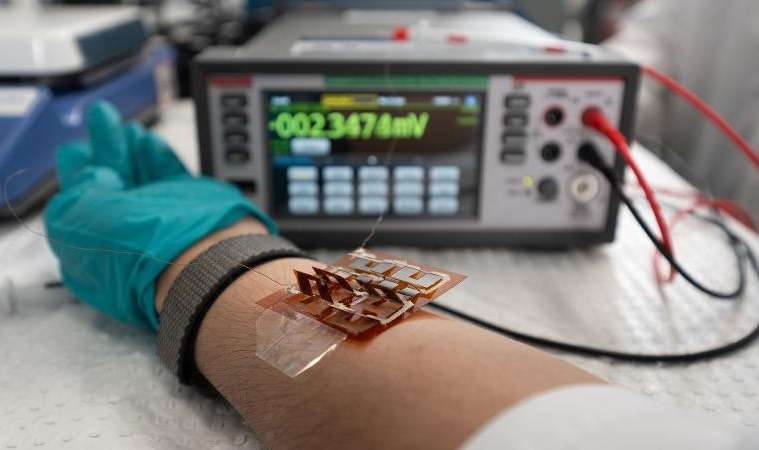Ultra-thin, flexible film could revolutionize next-generation wearable devices by converting body heat into a reliable power source, addressing one of the most persistent challenges in wearable technology: battery life. This innovative technology is poised to reshape the design and functionality of wearable electronics, making them more efficient, sustainable, and user-friendly. As wearable devices become increasingly integral to daily life, from fitness trackers to medical monitoring equipment, the integration of energy-harvesting systems using body heat represents a significant leap forward in making these devices more self-sufficient and less reliant on traditional charging methods.
The development of this ultra-thin, flexible film is the result of years of intensive research into thermoelectric materials, which have the ability to convert temperature differences into electrical energy. Scientists have worked to create a material that is not only efficient but also lightweight and adaptable to the human body. Traditional thermoelectric systems have been bulky and rigid, limiting their use in wearable applications. The new film, however, overcomes these limitations by using advanced materials that combine flexibility with high power output, ensuring that it can comfortably conform to the body while generating enough energy to power small devices.

One of the key advantages of this technology is its ability to harness a renewable energy source—the heat naturally emitted by the human body. The average human body generates a significant amount of heat throughout the day, much of which is wasted. By capturing and converting this energy into electricity, the film provides a sustainable alternative to batteries, which are not only environmentally taxing to produce but also add bulk and require frequent recharging. This breakthrough not only enhances the convenience of wearable devices but also aligns with broader efforts to reduce electronic waste and promote sustainable energy solutions.
The mechanics of this technology are rooted in the thermoelectric effect, a phenomenon where a temperature gradient across a material generates an electric current. In the case of the flexible film, one side is in contact with the skin, absorbing body heat, while the other side remains exposed to the cooler ambient air. This temperature difference drives the generation of electricity. Researchers have fine-tuned the material composition to maximize this effect, using a combination of semiconductors and conductive polymers that offer both efficiency and durability. The result is a material that can generate consistent power output even in low-temperature gradients, making it suitable for everyday use.
The potential applications of this technology are vast and transformative. In the healthcare sector, for instance, wearable devices equipped with this film could continuously monitor vital signs without the need for battery replacements, a critical factor in long-term patient care. For athletes and fitness enthusiasts, wearables powered by body heat could offer uninterrupted tracking of performance metrics, eliminating concerns about battery life during extended activities. Beyond personal devices, the technology could also find applications in industrial settings, where workers could use wearables to monitor safety conditions without worrying about power constraints.
Commercializing this technology involves several challenges, from scaling up production to ensuring affordability for consumers. While the film’s development has reached an advanced stage, translating it into mass-market products requires overcoming barriers related to manufacturing and integration with existing device architectures. Researchers are collaborating with industry partners to address these issues, focusing on developing cost-effective production methods and testing the material’s compatibility with various wearable designs. By working closely with manufacturers, they aim to bring this innovation to market within the next few years, potentially revolutionizing the wearable technology industry.
The environmental implications of this breakthrough are equally significant. Batteries, which currently power most wearable devices, are a major contributor to electronic waste. Many of these batteries contain hazardous materials that pose risks to both human health and the environment if not properly disposed of. By reducing or eliminating the need for batteries, the flexible film offers a cleaner, more sustainable solution. Additionally, its lightweight design reduces the overall material footprint of wearable devices, further contributing to sustainability efforts.
For consumers, the adoption of body heat-powered wearables represents a step toward greater convenience and functionality. The reliance on traditional charging methods, which often interrupt the user experience, has long been a pain point for wearable technology. With this film, users can enjoy continuous operation without worrying about running out of power or finding a charging outlet. This shift not only enhances user satisfaction but also opens up new possibilities for device design, as manufacturers can prioritize sleekness and comfort over accommodating bulky batteries.
As this technology moves closer to widespread adoption, it has the potential to influence the broader field of energy harvesting. Researchers are exploring ways to integrate similar systems into other everyday objects, such as clothing or accessories, further expanding the scope of renewable energy applications. Imagine a future where your jacket charges your smartphone or your backpack powers your laptop, all thanks to advances in thermoelectric materials. While these developments are still in the early stages, the progress made with the flexible film demonstrates the feasibility of such concepts.
Looking ahead, the success of this technology depends on continued investment in research and development, as well as collaboration between scientists, engineers, and industry leaders. Governments and private entities alike recognize the potential of renewable energy solutions and are providing funding and support to accelerate progress. Public awareness and demand for sustainable technology are also driving innovation, creating a favorable environment for the adoption of body heat-powered wearables.
The advent of ultra-thin, flexible film capable of powering wearable devices using body heat represents a groundbreaking development in technology. By addressing longstanding challenges related to battery life and sustainability, this innovation has the potential to transform the wearable device industry and beyond. As researchers and manufacturers work to bring this technology to market, it promises to deliver significant benefits to consumers, industries, and the environment. With its ability to harness renewable energy in a lightweight, adaptable form, this flexible film stands as a testament to the power of innovation in shaping a more sustainable and efficient future.










Add Comment